Table of Contents
ALL ABOUT ELECTRICITY

|
Melvin Berger’s Switch On, Switch Off (HarperCollins, 1990) in the Let’s-Read-and-Find-Out science series is a simple picture-book explanation of how electricity is produced, transmitted, and used, with helpful diagrams and a simple experiment involving a magnet, a compass, and a length of wire. For ages 4-8. |
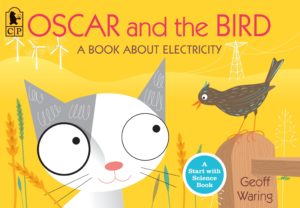
|
Geoff Waring’s Oscar and the Bird (Candlewick, 2011) in the Start with Science series begins when Oscar – a curious gray-and-white kitten – wonders what makes a tractor’s windshield wipers move. Luckily a competent brown bird arrives to tell him all about electricity, batteries, and circuits. For ages 4-7. |
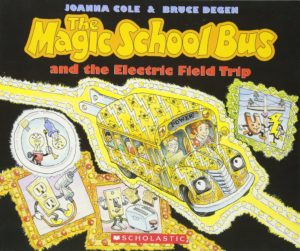
|
In Joanna Cole’s The Magic School Bus and the Electric Field Trip (Scholastic, 1999), one-of-a-kind teacher Ms. Frizzle explains electricity and takes her class on a trip through the power grid, via the (lightning-bolt-patterned) magic school bus. Much of the information is delivered via hand-printed kids’ school reports on lined notebook paper. For ages 5-9. |
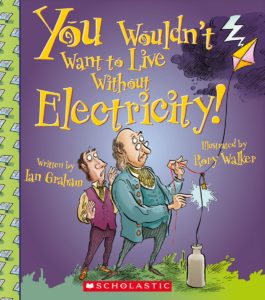 |
One of the You Wouldn’t Want to Live Without Series, Ian Graham’s You Wouldn’t Want to Live Without Electricity! (Franklin Watts, 2014) shows how people in the past made do without all the modern technological conveniences of today. Entertaining and informative for ages 8-11. Many other titles cover other things you wouldn’t want to live without, among them books, numbers, vaccinations, sleep, libraries, and clean water. |
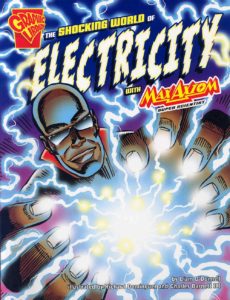
|
Liam O’Donnell’s graphic novel, The Shocking World of Electricity with Max Axiom, Super Scientist (Capstone Press, 2007), illustrated by Richard Dominguez and Charles Barnett, is one of a series starring superhero scientist Max Axiom, whose multitudinous superpowers include being able to shrink to the size of an ant or an atom, travel through time and space (with the help of a magic lab coat), or surf on a sound wave. There’s not much in the books by way of plot, but the text and cool comic-book graphics provide easily accessible information on the featured science topic, with help from supplementary fact boxes. For ages 8 and up. |
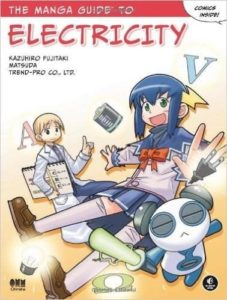
|
Kazuhiro Fujitaki’s 224-page Manga Guide to Electricity (No Starch Press, 2009) is a black-and-white graphic-novel-style introduction to electricity. The frame story is that of failed high-school student Rereko from the electrically advanced world of Electopia, sent to Earth to learn the fundamentals of electricity from a knowledgeable tutor. Topics covered include the physical nature of electricity, voltage and potential, electrical circuits, Ohm’s Law, resistivity and conductivity, current and magnetic fields, batteries and power plants, and semiconductors, diodes, and transistors. A reader-friendly and readily understandable approach to a complex topic for ages 12 and up. One of a series: other titles include The Manga Guide to Physics, The Manga Guide to Molecular Biology, and The Manga Guide to the Universe. |
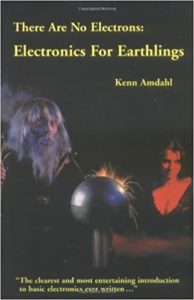
|
Kenn Amdahl’s 200+-page There Are No Electrons: Electronics for Earthlings (Clearwater Publishing, 1991) is a quirky, irreverent, entertaining, and scientifically thorough explanation of electrical concepts. Chapter titles include “Static Electricity: A Cat’s Nightmare,” “Circuits, Switches, Ants, Lizards and Pigs,” “The Intergalactic Steam Circus,” and “Vacuum Tube Diode: A Pickle Jar With a Purpose.” Amdahl’s inspiration for the book occurred when he realized that his sons, fans of Star Wars, had learned everything about Wookies, light sabers, and the Force – effortlessly. (“Yoda could have taught them Chemistry,” he wrote.) So why not write a book that made physical science as easy and absorbable as a movie? Here it is. For teenagers and adults. |
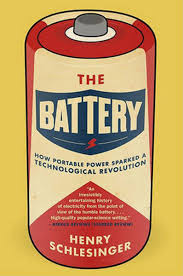
|
Henry Schlesinger’s The Battery (HarperPerennial, 2011) is a history of that small but all-important device from ancient Baghdad batteries, Galvani’s twitching frog legs, and Volta’s stack of zinc and copper discs to the present day. For older teenagers and adults. |
| Articles About Electricity is a collection of helpful reader-friendly explanations by an electrical engineer at the University of Washington. Topics include “What’s the relation between watts, ohms, amps, and volts?” “What is voltage?” and “How transistors really work.” Also at the site is a list of great “Build-It Projects,” among them an ultra-simple electric generator, an electrostatic motor made from plastic soda bottles, and instructions for generating ball lightning in the microwave. | |
| Voltage, Current, Resistance, and Ohm’s Law has background information, explanations, video demonstrations, and experiments. | |
| The History of Electricity: A Timeline is an annotated chronology of electrical discoveries, from Ben Franklin’s kite-and-key experiment to the first electricity-generating nuclear power plant. | |
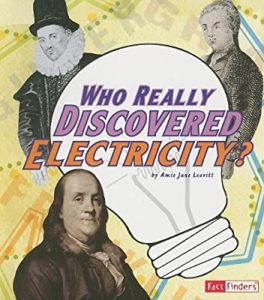
|
In the FactFinders series, Amie Jane Leavitt’s Who Really Discovered Electricity? (Capstone Press, 2011) covers the principal contributors and contenders, among them not only Ben Franklin, but English physician William Gilbert who in the year 1600 coined the word “electric,” and Italian physicist Alessandro Volta, who invented the battery. For ages 8-12. |
